Icon descriptions by Br. Matthew Sislow, OSB, with notes by Fr. Nathan Zodrow, OSB.
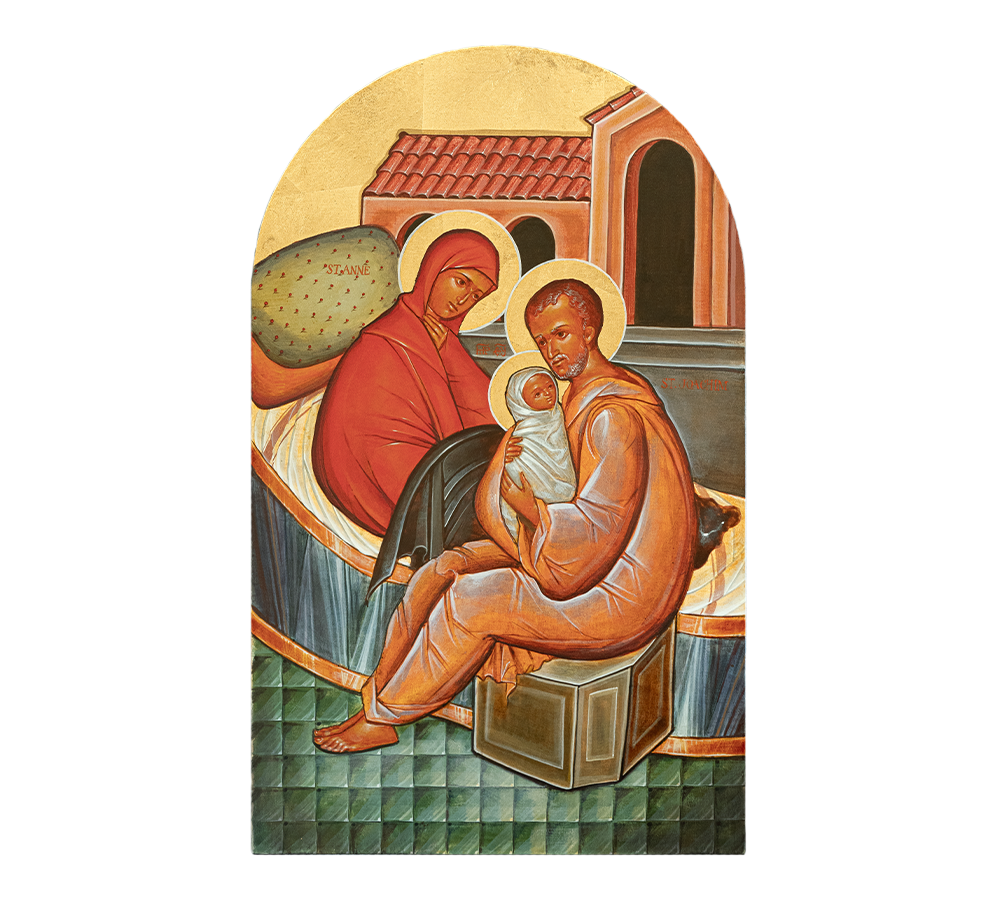
Nativity of Mary
Image: 24.5” x 15” | Acrylic on board
This icon shows the illustrious Saints Joachim and Anne, the parents of the Blessed Virgin Mary, at the time of Mary’s birth. Because of Mary’s perpetual virginity, icons traditionally show no man touching Mary except for Jesus himself and Joachim, her holy father. St. Joachim holds Mary tenderly as his wife, Anne, looks on lovingly from her reclining position after giving birth. The background is solid gold leaf. The gold provides the viewer with the understanding that this isn’t just an earthly scene; this is a holy place, a heavenly image seen here on earth.
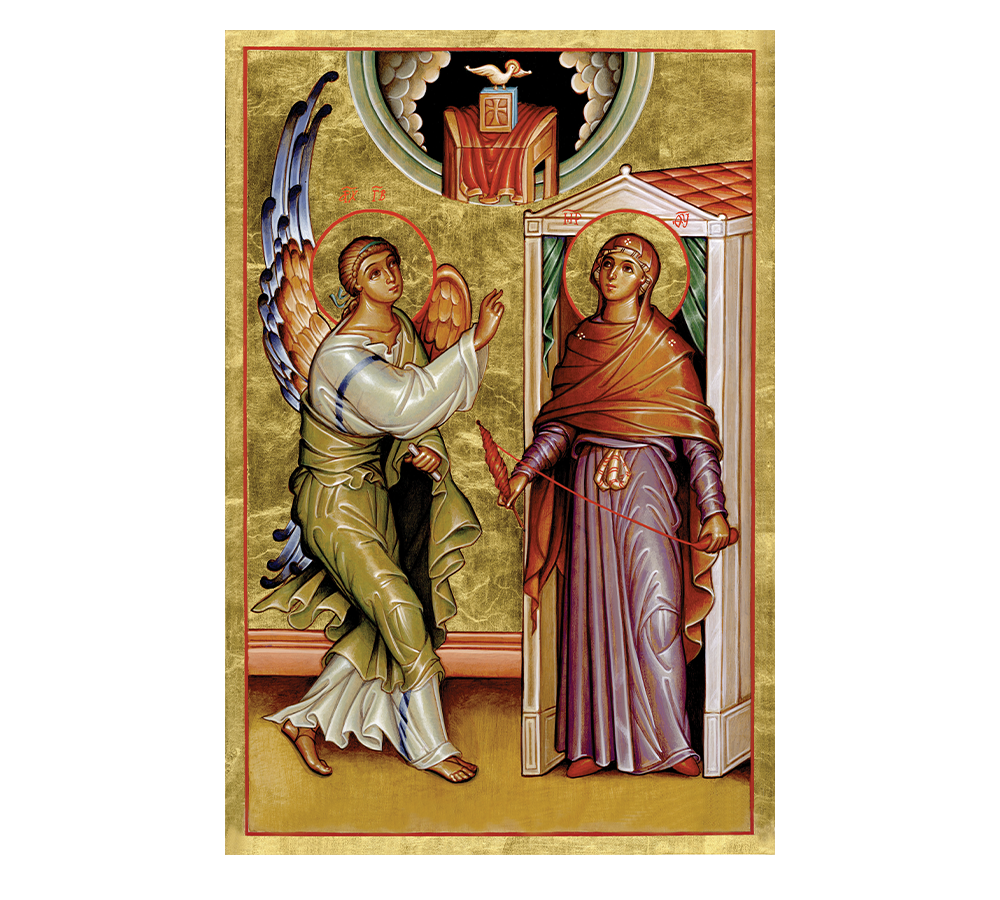
Annunciation of the Lord
Image: 17.5” x 11.5” | Acrylic on board
This icon is of the angel Gabriel announcing to Mary that she is to bear a son by the Holy Spirit. Gabriel’s stance indicates motion or action, the message he swiftly bears, while Mary’s posture shows openness to receiving that message according to God’s will. The Trinity is depicted above them in the iconographic style known as “The Prepared Throne.” God the Father is the empty throne on which no one is sitting, but he is revealed through his Word, portrayed as the book, and the Holy Spirit flows out from them, shown as a dove.
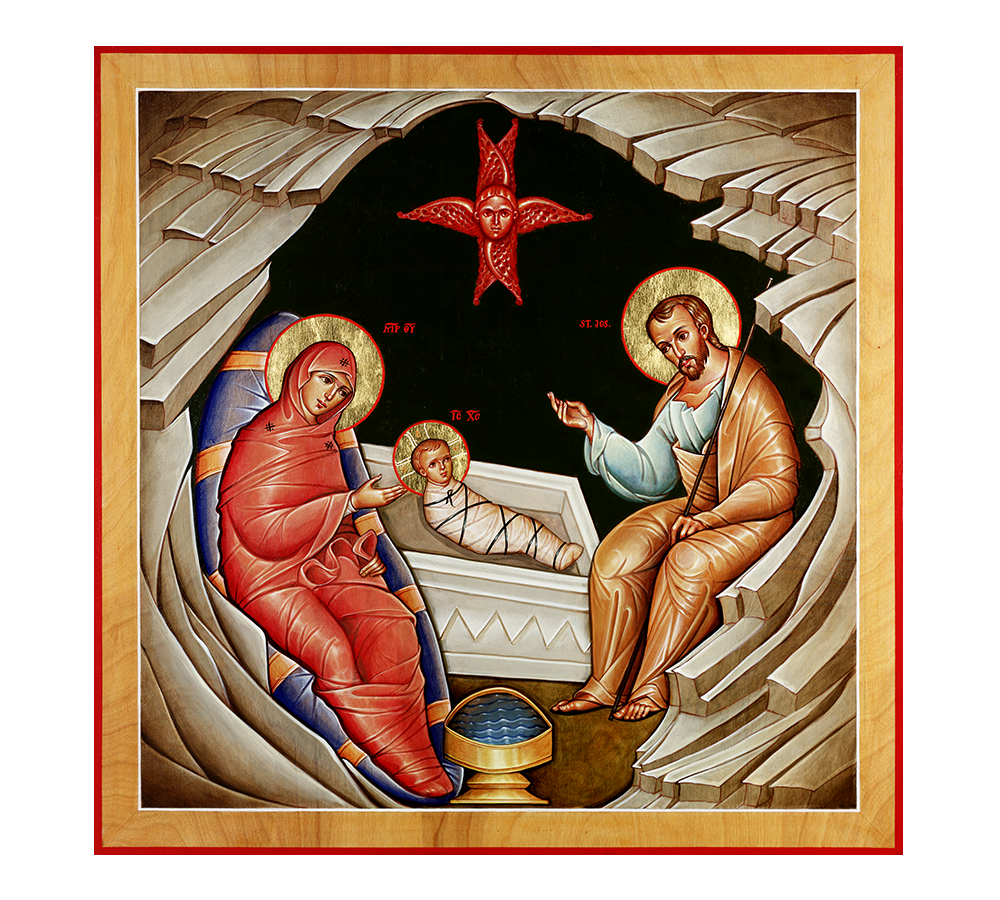
The Nativity of Jesus
Image: 3’ x 3’ | Acrylic on board
A large icon of the Nativity, Jesus is in the center in a crib, wrapped in swaddling clothes and a black cord; this cord that Mary once wore on her waist, symbolizing her pregnancy, now swaddles the newborn child Jesus. Mary is depicted in red, also seeming to be swaddled, and sits reclining on a blue cushion. St. Joseph sits with staff in hand, wearing a brown cloak over a blue tunic. A golden basin providing water for the birth is at their feet, and a six-winged Seraphim watches over the holy family from above.
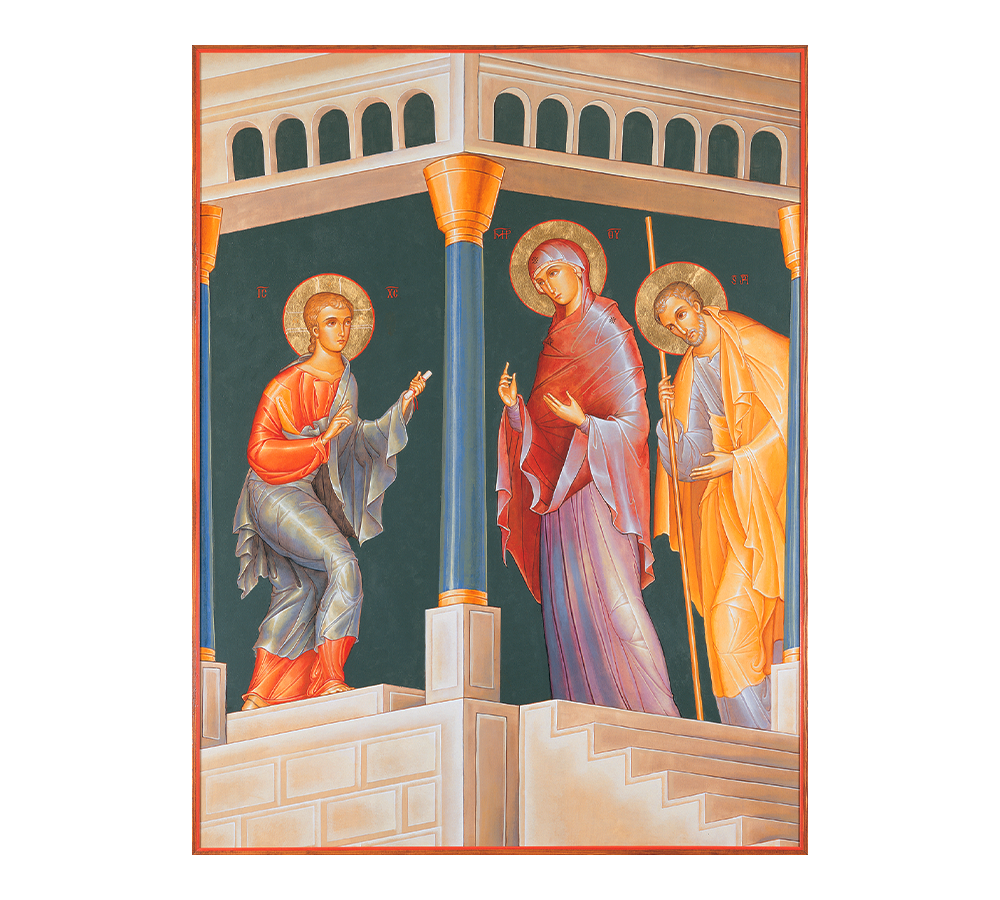
Finding Jesus in the Temple
Image: 62.5” x 48” | Acrylic on board
An icon depicting the scene from the Gospel of St. Luke, chapter 2, in which Jesus stays behind in Jerusalem after the feast of Passover. Mary and Joseph find him in the temple, “sitting in the midst of the teachers, listening to them and asking them questions.” A young Jesus is shown with a scroll in his left hand, symbolizing the Word of God. The scroll appears to be an important document because it has been officially sealed, meaning it is closed: nothing can be added or erased. His right hand is held in blessing (CWT). The prominent pillar down the middle divides the Divine Son from his earthly parents. Mary’s finger points upward, meaning she is speaking, while Joseph is bowed in silence.
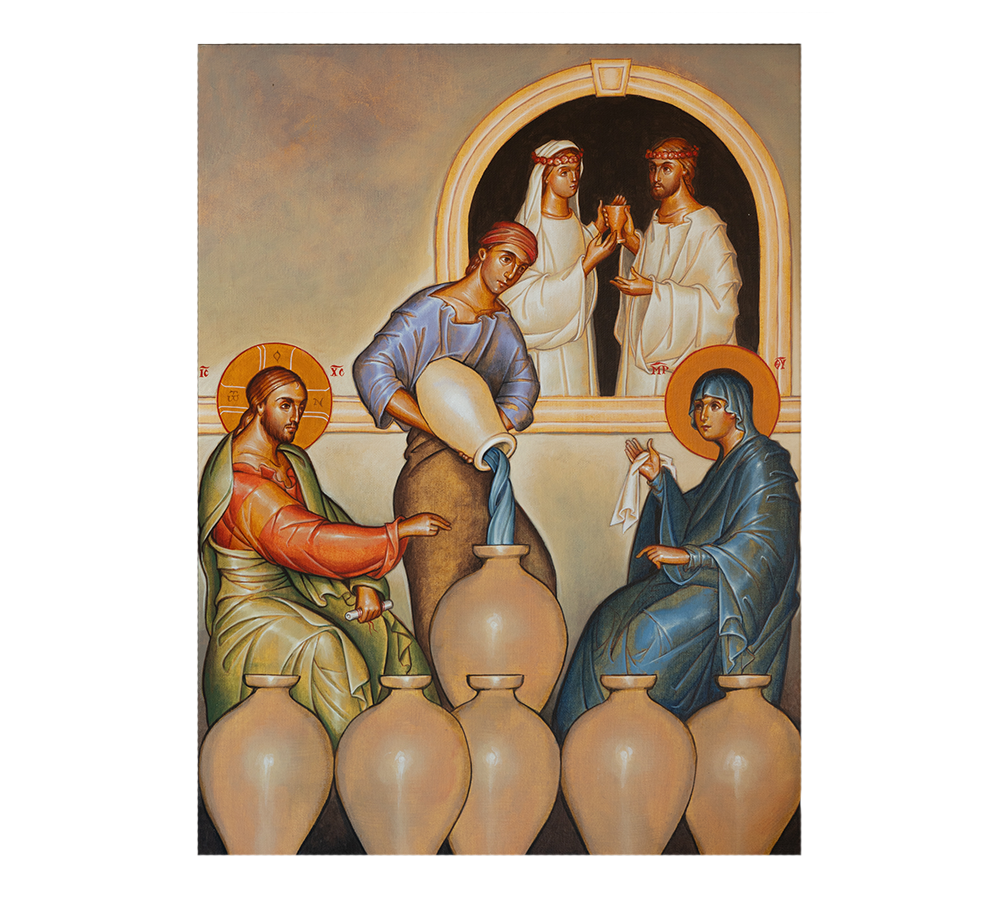 Wedding Feast of Cana
Wedding Feast of Cana
Image: 25.25” x 19.25” | Acrylic on board
Mosaic artist Lynne Chinn used this icon as the study piece for her mosaic representing the Sacrament of Marriage, which is included in a set of mosaics in the main hallway of Mount Angel Seminary’s Annunciation building. The scene depicts the story told in the second chapter of the Gospel of John, which recounts Jesus’ first miracle – changing water into wine at the wedding in Cana upon the request of his mother, Mary. A servant pours water into the six stone water jars; Jesus has his right hand raised in blessing over the water jars. Just as Christ blesses the new wine, he blesses marriage as a holy sacrament of the Church. Note the beautiful spill of water into the central wine jug.
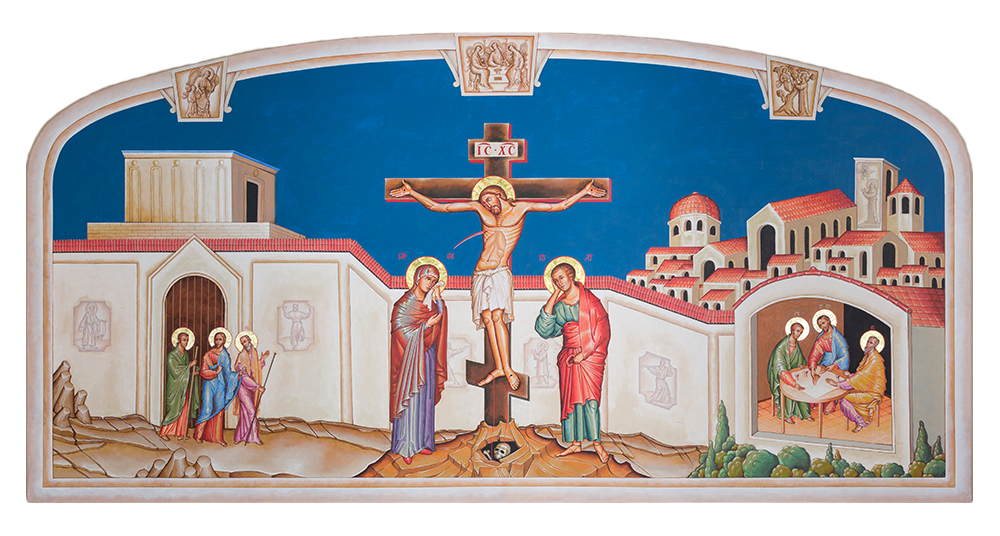
Crucifixion of Jesus
Detail: 75” x 48” (complete icon: 75” x 150.5”) | Acrylic on birch
The center of this large icon depicts the crucified Christ. Blood and water flow from his pierced right side while Mary, who symbolizes the Church, kneels below. Blood at his feet drips onto the bones of Adam, washing away the curse of death and sin. The Virgin Mary and St. John stand faithfully at the foot of the cross. Mary is seen wiping her eyes with a white cloth while reaching out to him with her right hand as she beholds her suffering son, depicting her as Our Lady of Sorrows. She wears a robe of dark blue as the Seat of Wisdom, showing an overtone of red reminding the viewer that she is the source of Christ’s humanity. Mary’s golden halo and red slippers depict her royalty.
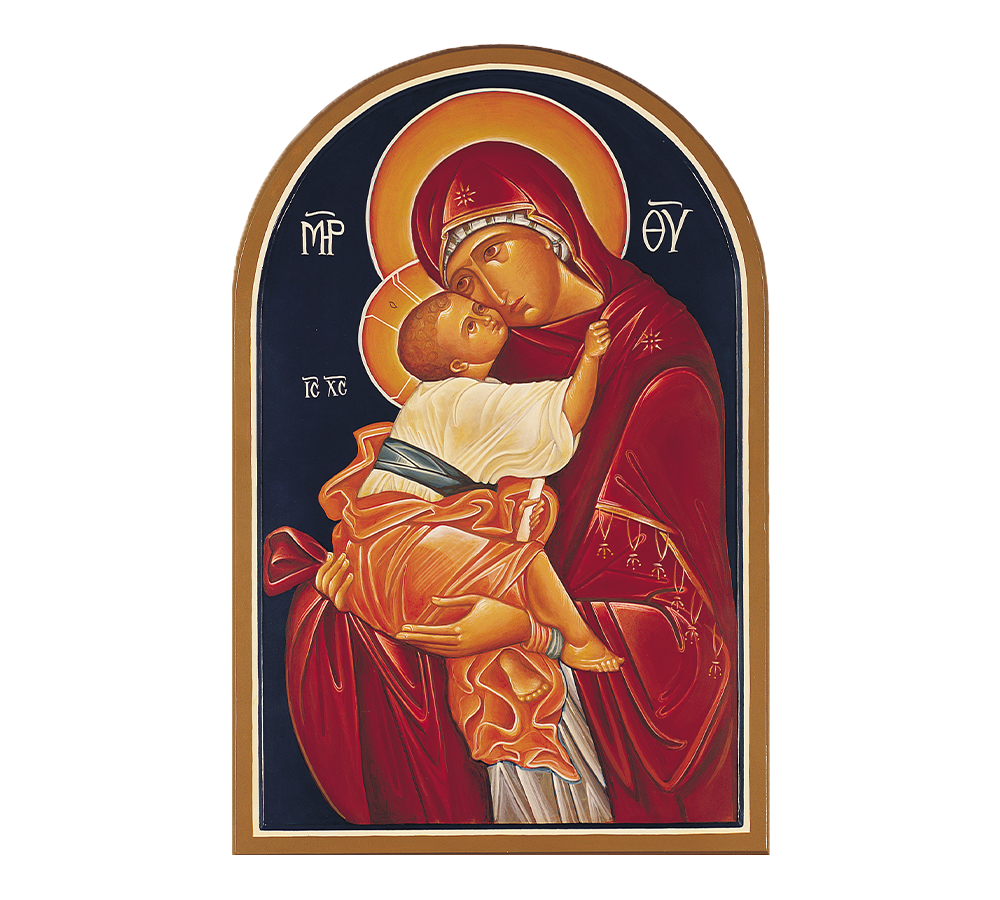
Mother of Tenderness
Image: 36” x 18” | Acrylic on board
This icon was based on a 12th-century Byzantine icon, originally showing the full body of Mary. Here, Mary’s body is shown in more of a portrait framing. In Greek, this icon may be classified as a glykophilousa, an image of Mary holding the child Jesus with their faces touching, iconographically depicting a tender kiss. She is dressed in red, and Jesus is in a white tunic with a blue sash and orange cloak. His right hand holds her by the shoulder, and his left hand holds a scroll of the Word.
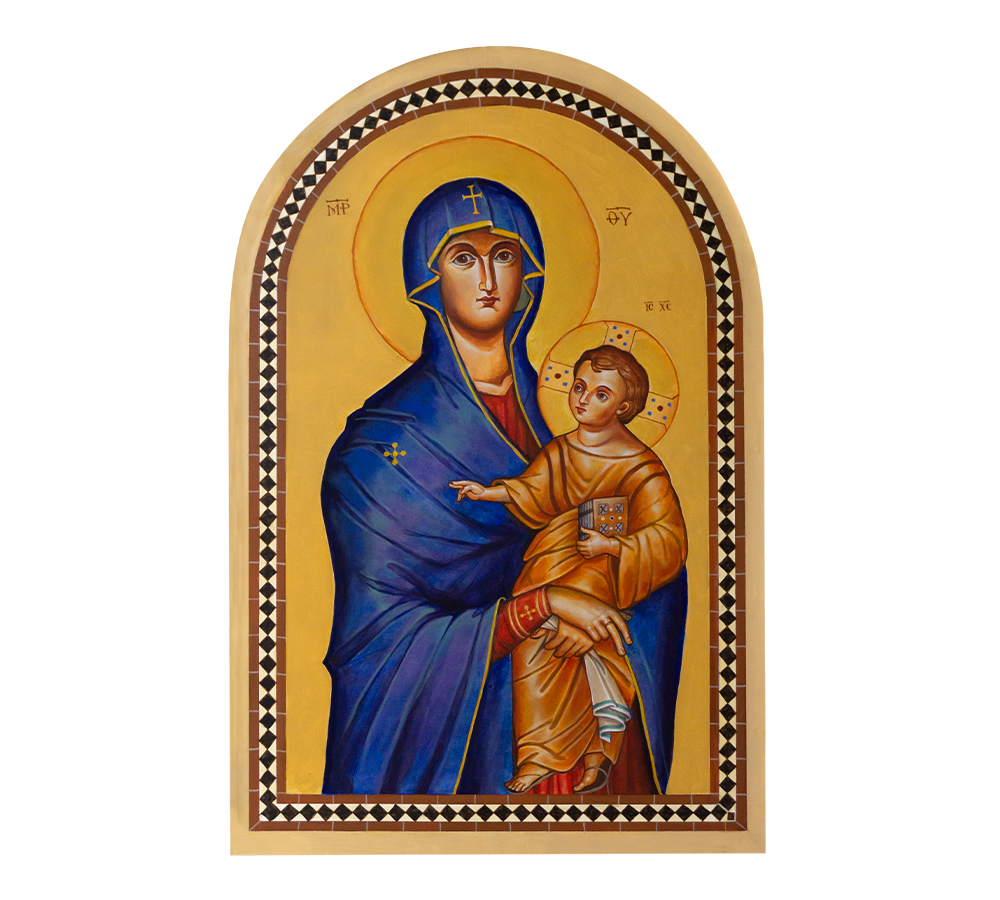
Salus Populi Romani
Image: 36” x 24” | Acrylic on board
The original of this icon, Our Lady, Salus Populi Romani, goes back to the 7th century, having traveled from Byzantium, up the Tiber, and finally to Rome, where it was received by Pope Gregory the Great. Not long after, a plague broke out. Earnestly, Pope Gregory led the people in procession and prayer to Our Lady and the plague abated. Hence, the painting received its current name, Our Lady, Salvation and Health of the People of Rome. Similarly, this icon was written in response to the Covid-19 pandemic to implore Mary’s protection for the monastery and surrounding areas.
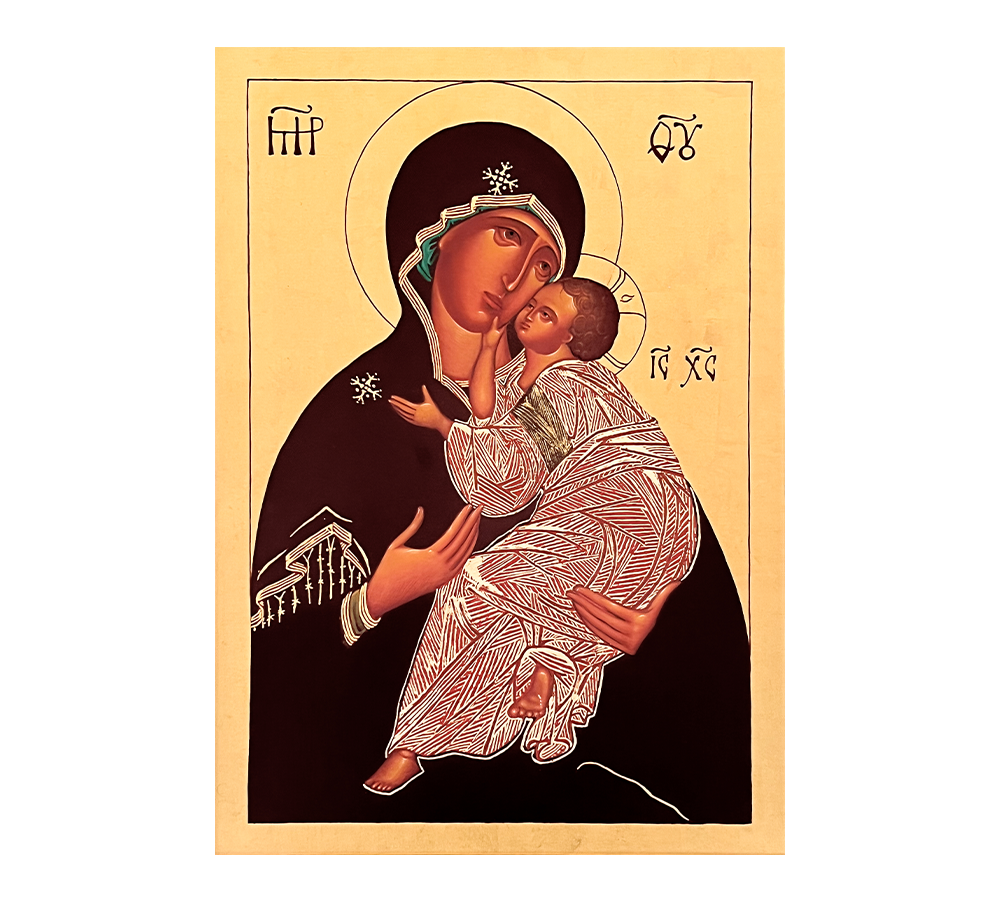
Our Lady of Kiev
Image: 30” x 15” | Acrylic on board
This beautiful icon is based on the typical rendering of Our Lady of Tenderness, from the highly acclaimed Our Lady of Vladimir, in Russia. The hallmarks of this style are the half-length Virgin Mary holding the Christ Child, with their cheeks tenderly touching. According to a description of Russian icons, this is meant to portray the absolute inseparability of Jesus from Mary and their unbreakable love for each other.
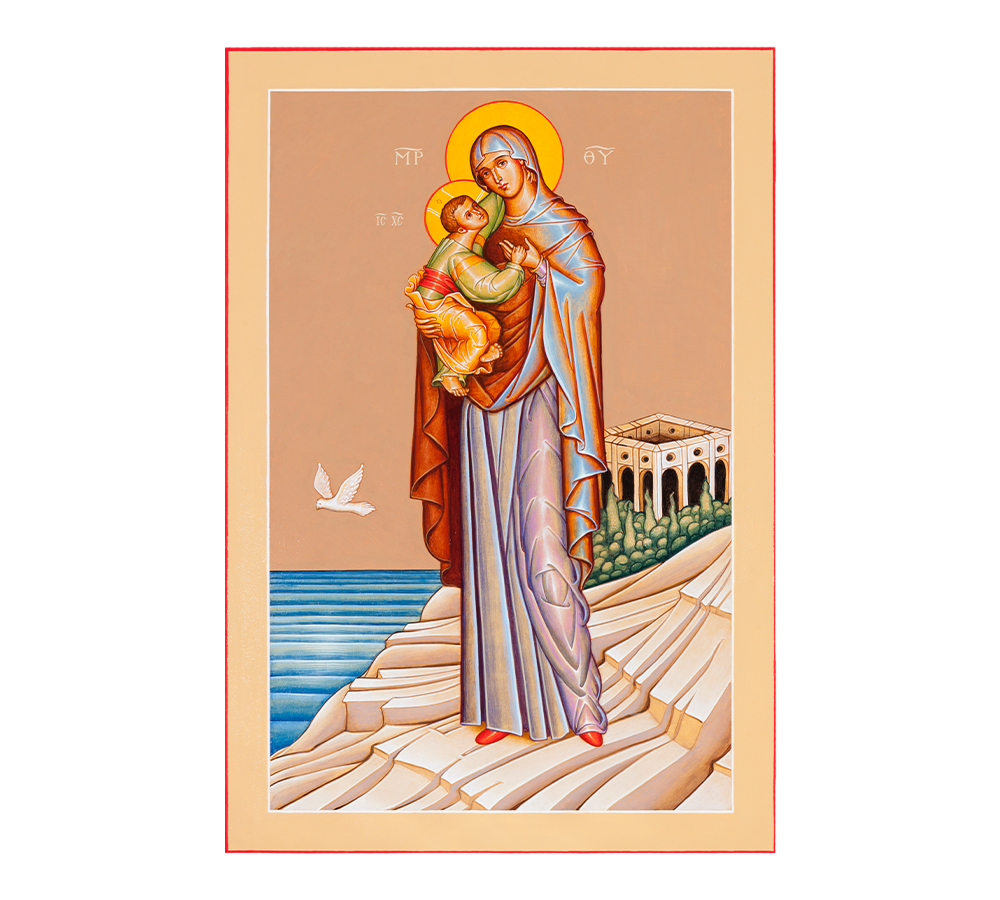
Pray for the Peace of Jerusalem
Image: 30” x 20” | Acrylic on board
This icon shows the Virgin Mary holding the child Jesus pairs with the icon He Shall Be Peace, continuing the theme of peace. The name is drawn from Psalm 122:6, May they pray for your peace, Jerusalem; those who love you – may they prosper. A dove is flying behind them, which is in continuity with the dove that Christ is holding in the partner icon.
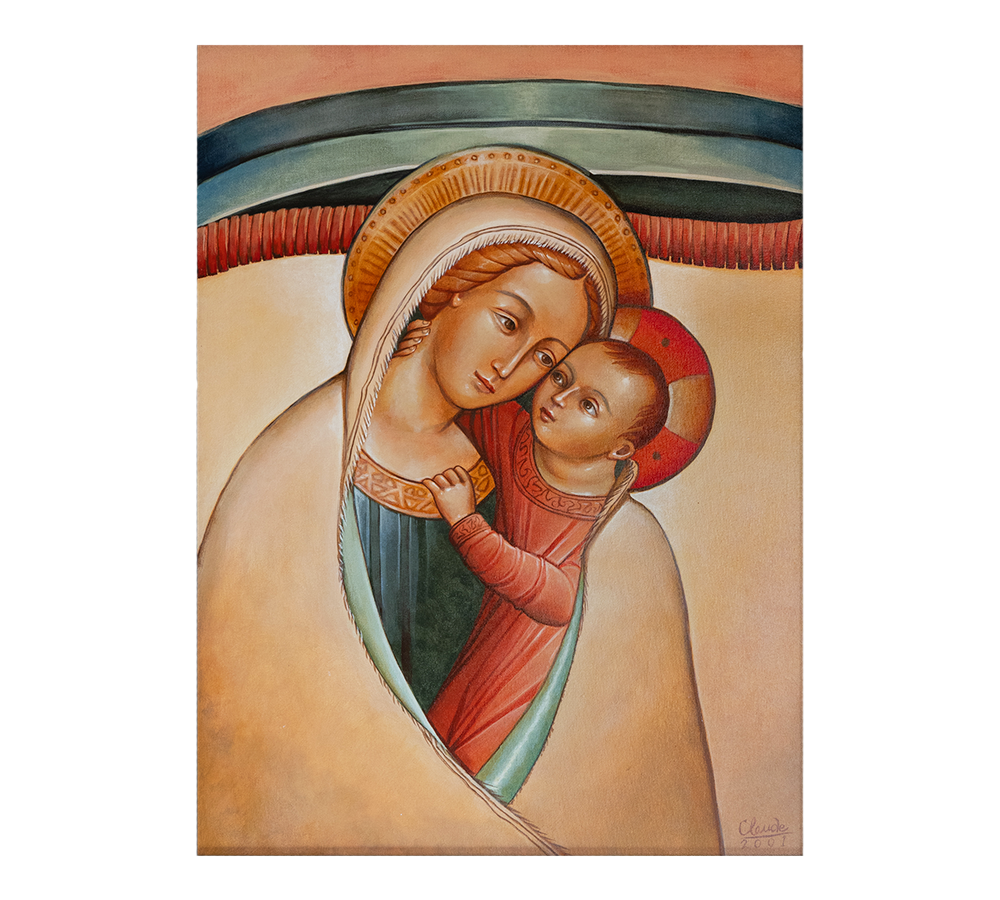
Mother and Child
Image: 24” x 18” | Acrylic on board
This soft, earthen-toned icon is inspired by the Mother of Tenderness, an icon in which a mother and child are touching cheeks as a sign of their inseparability. The background image represents a cloth hanging, an image of shelter.
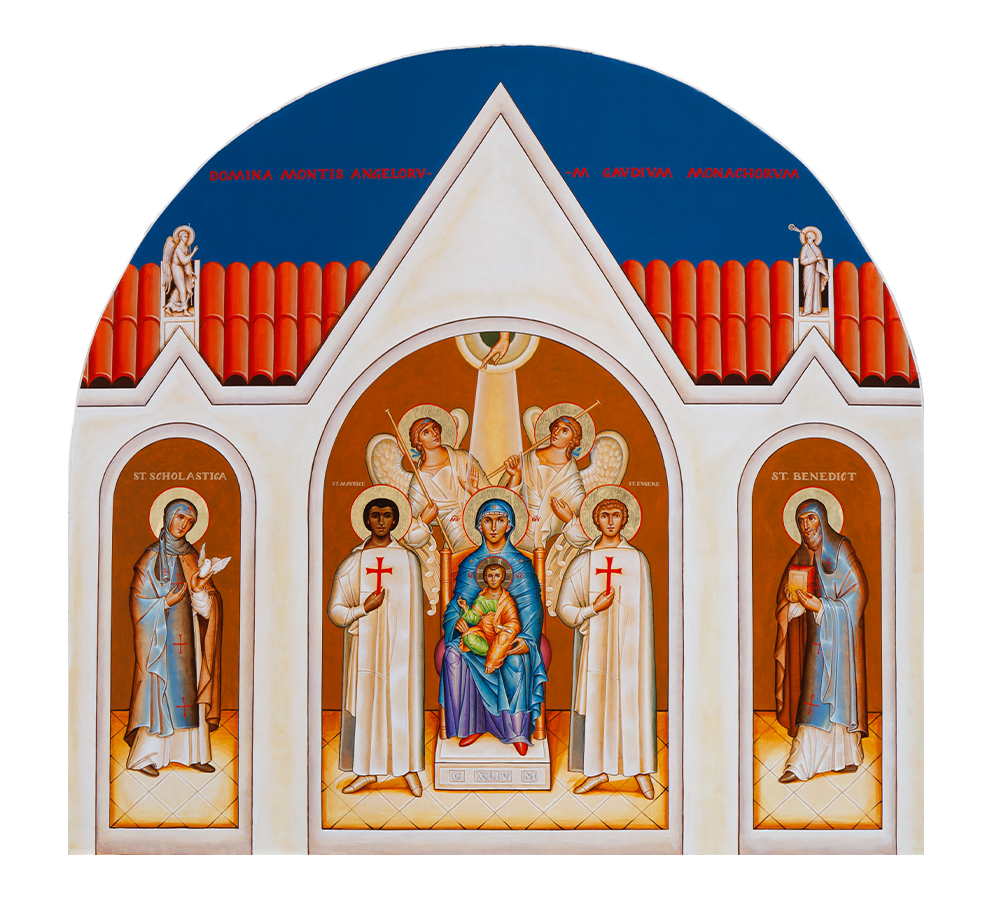
Mary, Joy of Monks
Image: 58” x 40” | Acrylic on board
The center panel of this icon depicts Mary with the child Jesus sitting on her lap. To their left and right are Sts. Eugene and Maurice, minor patrons of Mount Angel Abbey, flanked by two angels. God’s hand is seen above Mary, and his blessing shines down on her. Our Lady wears a deep blue mantle over a dark purple robe, symbolizing her royalty and wisdom, and red slippers, indicating a woman of high nobility. Jesus is donned with a golden mantle, depicting divinity and royalty, covering a green tunic signifying his life in the Holy Spirit. Two angels look up to God the Father, holding staffs, representing the presence of heavenly beings in our midst.






 Wedding Feast of Cana
Wedding Feast of Cana





